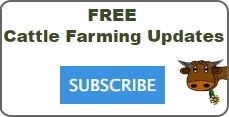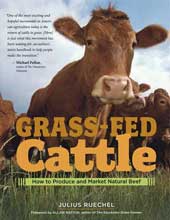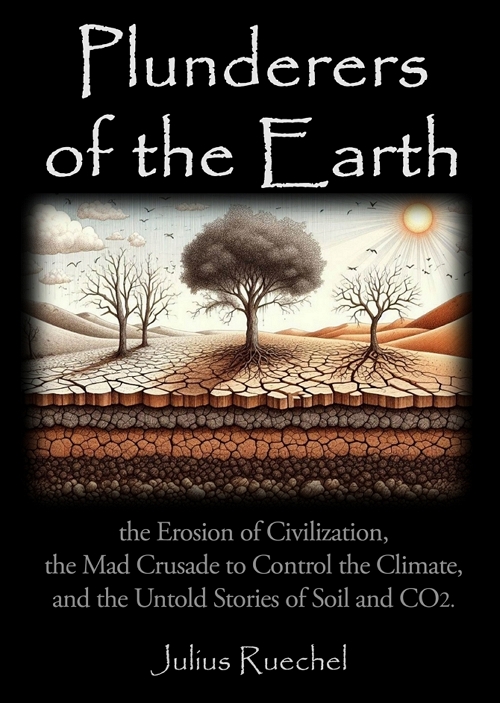The Seven Rules for Producing Great Beef: 1 2 3 4 5 6 7
Cattle Nutrition in your Grass Finishing Program
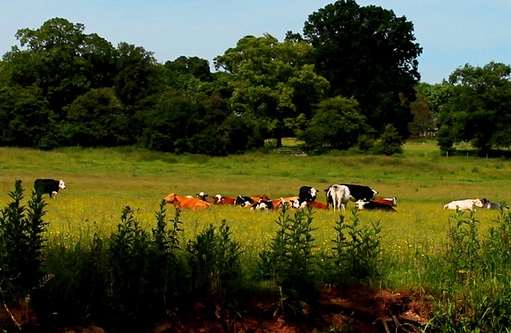
Image Credit: Les Haines, Flickr, CC BY 2.0
Stress from improper cattle nutrition has an equal or greater detrimental effect on beef tenderness and flavor compared to all other sources of cattle stress.
In Rule # 4 of the Seven Rules of Producing Great Beef I discussed how adrenalin released during stress undermines the tenderness and flavor of even the most well-finished beef. We also discussed the wide variety of stress sources that affect cattle and how they can be prevented through a good management strategy.
However, stress is not only confined to environmental, social, climate, disease, injury, or handling stresses. On this page I will examine how nutritional stress affects beef tenderness and flavor. And I will discuss several different potential causes of cattle nutritional stress in your grass finishing program and how they can be prevented.
(Rule # 5)
Cattle nutritional stress is equally damaging (or more) to beef tenderness and flavor than handling stress.
Defining Nutritional Stress
Let’s begin by identifying what nutritional stress actually is. In this section we’re not talking about starvation because there’s not enough food. While outright starvation is obviously a source of nutritional stress, the effects of actual food shortages are covered in Rules 1, 2, and 3. The cattle nutritional stress discussed here is far more subtle yet just as devastating to taste and tenderness as an actual food shortage even if it does not directly endanger the beef animal's life.
Nutritional stress is the subtle consequence of poor food quality, vitamin and mineral deficiencies, feed palatability issues (feed taste), water shortages or poor water taste, inconsistent feed schedules, or the social stress of a poorly designed grazing program that causes perceived food shortages, even if the calories available to each animal are sufficient on paper.
In Rule # 4 I discussed how stress releases adrenaline into the body, which changes the acidity of the meat and causes muscle fibers to tense up.
At first impulse it hardly seems worth getting stressed out about being late for a meal, not liking the flavors on the dinner menu, or missing a vitamin or two during lunch. However, as we dig deeper into the causes and consequences of nutritional stress it becomes very clear that the effect of nutritional stress on beef tenderness and flavor cuts right to the proverbial bone.
Let’s examine a few cattle nutritional stresses in detail to get a better sense of the wide ranging causes and effects of nutritional stress and how to prevent them in your grass finishing program.
Mineral and vitamin shortages
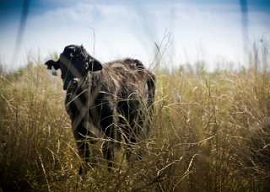
Image Credit: Lauren Mitchel, Flickr, CC BY 2.0

Image Credit: Lauren Mitchel, Flickr, CC BY 2.0
The most obvious consequence of a nutrient deficiency is if the deficiency directly leads to disease or health issues, which in turn would obviously affect an animal’s stress levels and cause adrenaline to be release.
But most mineral, vitamin and other cattle nutrition deficiencies never reach life-threatening levels so their consequences are far less obvious to the naked eye, yet still are detrimental to beef tenderness and flavor.
Trace elements (vitamins, minerals, etc) are absolutely essential for normal body functioning. When one is missing, in excess, or the ratios between various minerals is not in balance, the body does not function optimally. This leads to a host of issues; such as poor nutrient absorption of other minerals and nutrients, suboptimal metabolic functions, poor weight gains, increased irritability, and a range of other issues on a microscopic cellular level. Mineral deficiencies can even prevent weight gains even if the calorie-count of the feed is sufficient!
Vitamins and minerals affect important body functions. So deficiencies cause the animal not to feel as good. And feeling less than optimal is stressful, causes muscle tension and prompts the body to produce adrenalin. This translates to toughness in the beef (the effects of adrenalin are discussed at length in Rule # 4). Even sleep quality can be affected by nutrient deficiencies - ask any athlete or body builder how important good quality rest is to weight gains! Your cattle’s weight gains and stress levels are directly influenced by quality rest. Cattle nutrition and sleep quality are directly related.
Furthermore, the balance of vitamins and minerals themselves directly affect beef flavor. Just like a carrot that is low in calcium will be bitter, the flavor of beef from an animal that is deficient in any number of vitamins or minerals will also not taste as good. And a deficiency in one often causes a chain reaction of other deficiencies. For example, a calcium deficiency will prevent an animal from absorbing optimal levels of iron, or copper, or zinc from the diet even if these other elements are available in the food source. Minerals interact with one another and are not simply working in isolation within the body.
Mineral or vitamin deficiencies must be extreme before they become obviously detectable to the naked eye. But extreme deficiencies that are easily noticeable through obvious health issues and disease symptoms are extremely rare (such as a magnesium deficiency leading to grass tetany). They are the exception, the worst-case scenario.
Most mineral or vitamin deficiencies go unnoticed and unaddressed because there are no obvious symptoms and the effects are not easily visible. Instead they impact our cattle through reduced weight gains, lower fertility in our brood herd, increased vulnerability to disease and parasites, and by causing the beef to be less flavorful and tender when it finally reaches our dinner table because of the persistent low-level stress the animal experienced throughout the duration of the subtle mineral or vitamin deficiency.
In rare cases, if you are lucky and very observant, you might notice subtle clues that alert you to a possible mineral or vitamin shortage. For example, you might suspect a copper deficiency in animals that have trouble shedding their winter coat; you might suspect a protein deficiency if cattle are drinking from dirty urine-contaminated puddles instead of the clean water trough; or you might get suspicious of some other lurking vitamin, mineral, or cattle nutritional deficiency if your cattle are passing up a great looking feed source in order to eat some scruffy weed or less desirable looking feed source that contains the missing nutrients.
Unfortunately, however, 9 times out of 10 there will be no visible sign of a vitamin, mineral or nutrient deficiency. These deficiencies can only be determined through forage analysis (by sending feed samples to a laboratory for analysis) and by working with a cattle nutritionist.
A surprising number of people in the cattle industry think that if the grass is green it must be nutrient rich and their idea of a cattle nutrition and mineral supplement program is to toss an off-the-shelf salt block into the paddock, which they picked up at the feed store during a sale. They couldn’t be more wrong. It is costing them big time in weight gains, feed conversion efficiency, health costs, and beef flavor and tenderness. And it hits them in their pocketbook, but they don’t even know it’s happening because it’s all so subtle.
Preventing mineral or vitamin deficiencies:
Because vitamin and mineral deficiencies cannot be seen with the naked eye, cattle ownership must be accompanied by a comprehensive forage sampling program and must work with a cattle nutritionist to identify when the pasture and/or feed is able to supply all the cattle nutrition requirements and when supplementation is necessary.
The forage sampling program is designed to map out how the cattle nutrition values of your herd’s food supply changes over the course of the year as the animals graze different pastures, as cattle switch from pasture to hay or silage, and as seasonal changes affect the nutrients in the grass, such as when the plant matures, is leached by rain, or is hammered by frost.
A cattle nutritionist will compare the nutrients available in your cattle’s feed over the course of the year (identified by the forage sampling program) with the cattle nutritional requirements of your herd based on time of year, frame size, age, sex and so on, thereby allowing the cattle nutritionist to custom-design a year-round mineral, vitamin and nutrient supplement program for your grazing program. And your grass-finishing animals will likely require a very different supplement program than your yearlings, your cow/calf herd, or your first-calf heifers, since each group has very different cattle nutrition requirements.
The take-home point is that in order to be effective, the supplement program must be designed based on your individual forage sampling profile. Relying on off-the-shelf supplements won’t work because you don’t know if they really are what the cattle need. And you MUST work with a cattle nutritionist to determine what supplements are required.
The "Planning for Winter Grazing" and the "Your Herd Nutrition" chapters of Grass Fed Cattle explain how to work with a cattle nutritionist and how to set up a comprehensive forage analysis program for your rotational grazing program.
Designing a grazing strategy to avoid cattle nutritional stress
There are two additional strategies to help prevent cattle nutrition deficiencies in your grazing and grass finishing programs.
First is the grazing strategy itself. A daily pasture rotation ensures that the cattle have a consistent feed quality from one day to the next. Daily pasture moves also are are a powerful tool to optimize both the quantity and quality of your pastures. Pasture management plays a huge role in providing consistent high quality cattle nutrition to your herd.
The second preventative strategy for optimizing cattle nutrition is soil nutrient management strategy - which is a combination of your fertilizer program and your grazing strategy.
It’s no mystery that the nutrients available in the soil directly affect the nutrients available in the cattle feed. And addressing nutrient deficiencies in the soil is typically a lot cheaper than trying to compensate with a mineral supplement program later on. The exception is the case of community pastureland where farmers do not own the grazing land, or in extensive range-land in which it is either impractical or uneconomic to try to improve the lands with fertilizers. These lands must be managed through an effective grazing strategy alone, with a cattle nutrition supplement program designed to make up for shortfalls in their diet.
Any soil fertilization strategy that is used MUST be based on laboratory soil analysis. It is the only way to ensure that your fertilizer program is actually addressing your soil nutrient deficiencies. Many organic farmers only rely on compost, but without both a soil test and a compost analysis there is no way to ensure that your soils are actually getting what they need. Compost on its own may or may not provide the soil with the missing nutrients. For example, compost won’t cure a calcium deficiency in your pasture. And compost may even cause mineral imbalances in the soil to get worse, such as if a potassium-rich compost is applied to a soil already too high in potassium. Test your soils and design a fertilizer program to fit.
You can find more in-depth information about forage sampling, cattle nutrition supplements, and soil fertility management in the chapters entitled “Planning for Winter Grazing”, “Soil Fertility” and “Your Herd Nutrition Plan” in Grass-fed Cattle.
Using blood tests to identify cattle nutrition and mineral deficiencies:
Blood tests are insufficient for identifying nutrient and mineral deficiencies. They are only able to identify gross deficiencies, and they are extremely unreliable because the vitamin and nutrient levels change so much over the course of a day depending on how long it’s been since the last meal and what that last meal consisted of.
However, blood tests are an excellent secondary check that should be performed a few times per year on a random representative sample of the herd (it is not necessary to test the whole herd since they are all eating the same feed source...) to double check for really obvious cattle nutrition problems. However, they are not a substitute for a good forage sampling program because blood tests only provide a snapshot of a single moment in time, but do not provide any indication of whether supplementation is required to compensate for deficiencies in next week’s diet.
Eating cardboard - when the calories alone are not enough
Cattle nutritional stress is not limited to either calories, or minerals and vitamins. Sometimes there are plenty of calories in the food, but not enough protein to address all the cattle nutrition requirements.
Protein levels in a feed source change over the course of the growing season and are very different from one plant species to another. And cattle nutrition needs needs change constantly throughout the year depending on age, sex, growth stage, etc. Consequently, your forage analyses discussed in the previous section must include a full nutrient profile (carbohydrates, proteins, and fats) so your cattle nutritionist can also calculate when your cattle need a little extra feed supplement, such as an alfalfa protein supplement that can be mixed into the mineral supplement mix in order to compensate for a pasture or feed source that is a little too low in protein, even if it is not calorie-deficient.
Water - stress in liquid form...
Water can be an equally damaging form of cattle nutritional stress for an entirely different set of reasons: water shortages and water taste.
Water Shortages and Stress
Water is an essential ingredient in weight gains. Approximately 75% of muscle tissue is water. If there isn’t enough water, the beef animal stops gaining weight. Period. Water is required for digestion, so if water is in limited supply, the beef animal must eat less.
Being thirsty is stressful. If a water supply is insufficient to provide for a herd of cattle’s water needs, stress levels in the herd will skyrocket, gains will drop off, adrenalin levels will rise and beef flavor and tenderness will be damaged.
It is surprising how often the water source in a pasture is insufficient to meet the needs of the herd using it - often it was designed for a smaller herd and was not adjusted for a different grazing strategy or larger herd. Or, the water system may have been sized for a cow-calf program, but the pasture has now been converted for grass-finishing or stocker cattle. As a result, the available water may still be sufficient for survival, but not for optimal weight gains. And the shortage will cause extreme cattle stress.
All grazing and grass-finishing programs should periodically retest each and every water source on their farm to ensure that flow rates have not changed over time and are adequate for the current herd size. And every water source must be retested whenever a farmer makes any major change to how they raise cattle, such as when they convert from traditional cow-calf to grass-finishing or if they increase their cattle herd size.
You can learn more about how to calculate the daily cattle water requirements by following the link.
Perceived Water Shortages
Furthermore, the ‘perception’ of a water shortage can also be a
significant source of stress. This is where cow psychology comes into
play. If cattle cannot see the water source from where they are grazing,
they will often travel to water as a group. And if the water source is
not able to provide for the entire herd in one single sitting (within a
very short period of time), thirsty animals will get nervous and start
hogging the water trough, fighting with others to prevent access.
There
may be enough water supplied to the trough over the course of the day
to provide for the entire herd, but if cattle have to wait for it for
half the day to get their share, weight gains in your grazing program will dwindle away while competition and stress rises
over a resource that is, however temporarily, in short supply.
Fixing this issue is simply a matter of sizing troughs, pipes, water pressure, and possible on-site water storage tanks according to the herd using them so that water is able to meet not only the daily water requirements of your herd, but that flow rates are also able to meet peak demand.
And again, when
the farmer changes the herd size (such as buying more land, growing the
herd numbers, or switching to a different animal age group), all these
calculations must be performed all over again if the grazing and water
system was not pre-designed with the change in mind.
You can
read more about how to calculate your cattle herd's daily and peak water requirements, as well as
how to calculate pipe diameter, friction losses, pressure loses, and
trough sizes, and how to design and build cost-effective water storage
systems “Livestock Water” chapter of Grass-fed Cattle.
Water Taste
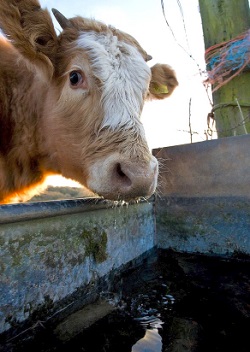
Image Credit John Goode, Flickr, CC BY 2.0

Image Credit: John Goode, Flickr, CC BY 2.0
Then there’s the taste of the water itself.
If water tastes lousy or is contaminated with manure, urine or some other bacterial or chemical contaminant, the cattle will reduce how much of the nasty stuff they drink, and will reduce their feed intake accordingly.
This can cause temporary calorie shortfalls (Rule # 3) or even cause weight gains to fall off altogether (Rule # 1).
Algae growing in the trough, muddy waterholes, excessive iron in the water, or manure and urine draining into a pond can all be a source of stress for cattle. Think of your enthusiasm for a glass of water if you had to live off of water scooped from a public toilet.
Rule of thumb, if it isn’t fit for you to drink or if you wouldn't enjoy the taste, don’t force it on your cattle. Fix your water system.
Water Access
And finally, there’s the access to the water site itself.
A treacherous access point, like a slippery clay slope, a frozen river bank, or belly-deep mud pit that must be navigated to reach the water source will cause stress among your cattle (and the adrenaline associated with stress will in turn affect beef tenderness and flavor).
Furthermore, if access to the water source is not simple and safe your cattle to reduce their feed intake, which will further affect weight gains, fat content in the meat, and ultimately beef tenderness and flavor.
The Consistent Feed Schedule
f you get three square meals a day, but those meals are inconsistent (i.e. sometimes you don’t get your first meal until 3 pm, other days you get all three meals before 11 am), it’s very stressful for your system for much the same reason that an inconsistent sleep schedule throws your whole system out of whack. The extreme case is jetlag, and we all know how disorienting and stressful that can be.
A consistent schedule allows our bodies to function consistently; anything that throws that schedule out of whack is stressful.
Cattle are no different in this regard. Feeding times or pasture rotations should happen at the same time each day, with as much consistency as possible in order for the cattle’s digestive and metabolic functions to function optimally.
Watch what happens to the behaviour of your cattle herd if you are a few hours late to open a gate in a pasture rotation after the cattle have adjusted to your routine. If you are lucky, there will just be a huge amount of commotion at the gate and a nervous rush through once it is opened, all of which are signs of stress. If you are not so lucky, the cattle will have opened the gate for you - like a bulldozer - turning ordinarily calm, well-behaved, fence-respecting cattle into impatient, quarrelsome, belligerent wrecking machines. It doesn’t take a lot of imagination to think of how this is likely to affect their meat tenderness and flavor. All because you messed with their routine...
So make sure your pasture moves follow a consistent daily schedule!
Stress at the dinner table.

The proverbial ‘atmosphere around the cow’s dinner table’ makes all the difference to whether a mouthful of clover leads to nervous indigestion or a relaxed nap under the apple tree. And that difference translates directly into the tenderness and flavor of the beef as adrenaline is produced in response to stress.
There are some obvious cattle stresses that should be avoided whenever you are handling your cattle that fall under Rule # 4 - such as whooping and hollering during pasture moves, running cattle, having a dog nipping at their heels, or being disturbed by kids racing their motorbikes along the edge of the pasture.
But in addition to that is the stress arising from competition for feed or for space at the feed trough.
Daily pasture moves promote healthy competition among the herd - all of which have equal access to a daily grazing slice. However, when feed troughs are too small, or if hay-feeders are sized too small, or mineral feeders are too small, a huge amount of unhealthy competition arises between animals for access to the limited resource, even if everyone would get their fill eventually if the laggards simply waited for their turn.
Cattle don’t wait in orderly lines and don’t give each other guarantees that they will share equally. It’s a free-for-all, so if there is a perceived shortage caused by a poorly-designed feeding system, the frenzy and stress begins.
Even allowing cattle to run through a gate to a new pasture creates a temporary sense of a shortage that increases stress and affects the atmosphere around the cow’s dinner smorgasbord. The perception of a shortage is typically far more stressful than the actual shortage. There may not even be an actual shortage. But it is cattle perceptions, not realities that matter. Not only is it very stressful to wrestle with competitors to access a limited resource, but think of how stressful it is to feel like you are missing out! - even if you’re not.
Think of the mania that grips crowds when they find out that tickets to a popular rock star’s concerts are almost sold out, or when a famous celebrity is sighted on a street. That’s the same stress cattle feel when they start competing with one another for access to a feed bunk or slow-filling water trough, or when they race one another to get through a gate first.
I come from a family of four kids - I know how panicky it can get around the dinner table when there are only three slices of cake left. The same thing goes for the clover patch in the cow pasture...
Or consider the panic during the 2011 nuclear crisis in Japan, when people in America, far beyond any imaginable reach of nuclear contamination, managed to bid up the price of iodine pills, rumored to protect against radiation, from a mere $10 per packet to $540 per packet! And in China, store shelves across the country were stripped bare of salt overnight for the very same reason, amidst severe price gouging and despite absolutely no evidence that salt does anything to protect against radiation. But once group think sets in, the crowd panics, mania sets in, and logic and calm go by the wayside.
Cattle are even more susceptible to group think. Irrational stress about perceived shortages and manic stress about which cow gets access to food first. Watch what happens when just a single animal at the front of the herd starts to run through a gate. The rest have no idea what made the first animal run, they just run too. Are they fleeing, or racing to clover? No-one knows. Stampede first, think later. Stress is the go-to option.
Cattle are the ultimate herd animal where group think rules. So keep it calm around your cattle’s dinner table or suffer the consequences in your grass finishing program.
Stress is Sticky...
We tend to think of stress as an event, as something that ends as soon as the cause of the stress is taken away. Unfortunately, stress doesn’t work like that.
Stress and its effects tend to stick around long after the cause of the stress is gone, fading only very gradually, but returning very suddenly at the first sight of a possible repeat. We’ll explore this in detail in Rule # 6 of the Seven Rules of Producing Great Beef.
Continue to:
Related Articles:
(Disclosure: I get commissions for purchases made using Amazon links in my post.) And when you're ready to start planning your cattle farm, check out my book: Grass-Fed Cattle: How to Produce and Market Natural Beef. Use the links below to explore my book and read reviews on Amazon: 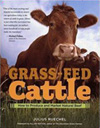
|

